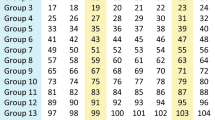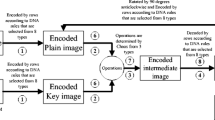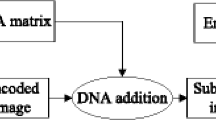Abstract
Millions of confidential images are transmitted every day by people through the multimedia systems of the internet. Such confidential information in the images may be belong to the political, business, medical or military authorities. Protecting the privacy and integrity of these images in the era of the internet and multimedia technologies has drawn more attention by the research community. Image encryption is one of the most important tools to secure digital images from the unauthorized access and malicious manipulation. In this paper, a new digital image encryption method is proposed based on bit replacing technique, chaotic systems and DNA coding algorithm. It aims to protect the confidentiality and privacy of the digital images sent over unsecure open channels. Firstly, in this method each pixel of the image is converted to its corresponding binary sequence comprising of zeros and ones bits. Then, the zero bit is replaced by (1 and 0) bits and the one bit is replaced by (0 and 1) bits. Two different images are eventually generated by repeating consistently the replacing operation for all bits of the image pixels. Secondly, the generated images are encrypted using high dimensional chaotic systems based on the principle of permutation and diffusion processes in objective to vary the positions and values of the digital image pixels. Thirdly, the resultant encrypted images are encoded by adopting DNA algorithm rules and then these images are merged by exploiting DNA addition operation. Finally, the coded DNA images are decoded to obtain the output encrypted image. The numerical and visual simulation results confirm that the proposed method is sufficiently robust and secure against several known attacks in comparsion with the state-of-art approaches. Also, the conducted experiments show significant improvement in terms of entropy, correlation, differential, discrepancy metrics, key space and computational speed analysis performance parameters. To sum up, the proposed approach produced large secret key space of (2747), a comparable differential analysis performance NPCR (99.61%) and UACI (34.61%) and passed all security and randomness tests.

















Similar content being viewed by others
References
Abboud AJ (2015) Multifactor authentication for software protection. Diyala J Eng Sci Second Eng Sci Conf 08(04):479–492
Abboud AJ, Jassim SA (2010) Image quality guided approach for adaptive modelling of biometric intra-class variations." In Mobile Multimedia/Image Processing, Security, and Applications 2010, Vol. 7708, International Societyfor Optics and Photonics. p. 77080L
Abboud AJ, Jassim SA (2012) Incremental fusion of partial biometric information. In Mobile Multimedia/Image Processing, Security, and Applications 2012, Vol. 8406, International Society for Optics and Photonics. p. 84060K
Abboud AJ, Albu-Rghaif AN, Jassim AK (2018) Balancing compression and encryption of satellite imagery. Int J Electr Comput Eng 08(5):3568–3586
Abdullah HN, Yousif SF, Valenzuela AA (2016) Wavelet Based Image Steganographic System Using Chaotic Signals. 2016 6th International Conference on Information Communication and Management. IEEE pp. 130–135
Abdullah HN, Yousif SF, Valenzuela AA (2018) Spatial and transform domain based steganography using chaotic maps for color images. J Fundam Appl Sci 10(4S):551–556
Abdullah HN, Yousif SF, Valenzuela AA (2019) Efficient steganography scheme for color images based on wavelets and chaotic maps. Iraqi J Inf Commun Technol (IJICT) 2(4):1–10
Ayubi P, Setayeshi S, Rahmani AM (2020) Deterministic chaos game: a new fractal based pseudo-random number generator and its cryptographic application. J Inf Secur Appl 52:1–20
Bandyopadhyay D, Dasgupta K, Mandal JK, Dutta P, Ojha V, Snasel V (2014) A framework of secured and bio-inspired image steganography using chaotic encryption with genetic algorithm optimization (CEGAO). Proceedings of the Fifth International Conference on Innovations in Bio-Inspired Computing and Applications IBICA 2014. Springer pp. 271–280
Chai X (2015) An image encryption algorithm based on bit level Brownian motion and new chaotic systems. Multimed Tools Appl Springer 76:1159–1175
Chai X, Yang K, Gan Z (2016) A new chaos-based image encryption algorithm with dynamic key selection mechanisms. Multimed Tools Appl Springer 76:9907–9927
Chai X, Gan Z, Zhang M (2016) A fast chaos-based image encryption scheme with a novel plain image-related swapping block permutation and block diffusion. Multimed Tools Appl Springer 76(14):15561–15585
Chai X, Chen Y, Broyde L (2017) A novel chaos-based image encryption algorithm using DNA sequence operations. Opt Lasers Eng 88:197–213
Chai X, Gan Z, Yuan K, Chen Y, Liu X (2017) A novel image encryption scheme based on DNA sequence operations and chaotic systems. Neural Comput & Applic 31:219–237
Chen Y, Tang C, Ye R (2020) Cryptanalysis and improvement of medical image encryption using high-speed scrambling and pixel adaptive diffusion. Signal Process 167:1–12
Deebak BD, Al-Turjman F, Nayyar A (2020) Chaotic-map based authenticated security framework with privacy preservation for remote point-of-care. Multimed Tools Appl Springer 80:17103–17128
Deng X, Liao C, Zhu C, Chen Z (2013) A novel image encryption algorithm based on hyperchaotic system and shuffling scheme. 2013 IEEE International Conference on High Performance Computing and Communications & 2013 IEEE International Conference on Embedded and Ubiquitous Computing pp. 109–116
Flores-Vergara A, García-Guerrero EE, Inzunza-González E, López-Bonilla OR, Rodríguez-Orozco E, Cárdenas-Valdez JR, Tlelo-Cuautle E (2019) Implementing a chaotic cryptosystem in a 64-bit embedded system by using multiple-precision arithmetic. Nonlinear Dyn Springer 96:497–516
Fu C, Zhang G, Zhu M, Chen Z, Lei W (2018) A new Chaos-based color image encryption scheme with an efficient substitution keystream generation strategy. Security and communication. Networks:1–13
Gang- QS, Hui C, Yan-Bin Z (2011) A new four-dimensional hyperchaotic Lorenz system and its adaptive control. Chin Phys Soc IOP Publ Ltd 20(1):1–9
García-Guerrero EE, Inzunza-González E, López-Bonilla OR, Cárdenas-Valdez JR, Tlelo-Cuautle E (2020) Randomness improvement of chaotic maps for image encryption in a wireless communication scheme using PIC-microcontroller via Zigbee channels. Chaos, Solitons Fractals 133(109646):1–12
George LE, Hassan EK, Mohammed SG, Mohammed FG (2020) Selective image encryption based on DCT, hybrid shift coding and randomly generated secret key. Iraqi J Sci 61(4):920–935
Guodong Y, Chen P, Xiaoling H, Qixiang M (2018) An efficient pixel-level chaotic image encryption algorithm. Nonlinear Dyn, Springer 94:745–756
Hameed AS (2017) Image encryption based on fractional order Lorenz system and wavelet transform. Diyala J Eng Sci 10(01):81–91
Hua Z, Zhou Y (2017) Design of image cipher using block-based scrambling and image filtering. Inf Sci 396:97–113
Huang L, Wang S, Xiang J, Sun Y (2020) Chaotic color image encryption scheme using deoxyribonucleic acid (DNA) coding calculations and arithmetic over the galois field. Math Probl Eng:1–22
Irani BY, Ayubi P, Jabalkandi FA, Valandar MY, Barani MJ (2019) Digital image scrambling based on a new one-dimensional coupled sine map. Nonlinear Dyn Springer 97:2693–2721
Jithin KC, Sankar S (2020) Colour image encryption algorithm combining, Arnold map, DNA sequence operation, and a Mandelbrot set. J Inf Secur Appl 50:1–22
Khan M (2015) A novel image encryption scheme based on multiple chaotic S-boxes. Nonlinear Dyn Springer 82:527–533
Khan M, Shah T (2014) A novel statistical analysis of chaotic S-box in image encryption. 3D Res Springer 5(16):1–8
Li Y, Wang C, Chen H (2017) A hyper-chaos-based image encryption algorithm using pixel-level permutation and bit-level permutation. Opt Lasers Eng 90:238–246
Li Z, Peng C, Li L, Zhu X (2018) A novel plaintext-related image encryption scheme using hyper-chaotic system. Nonlinear Dyn Springer 94:1319–1333
Li T, Shi J, Li X, Wu J, Pan F (2019) Image encryption based on pixel-level diffusion with dynamic filtering and DNA-level permutation with 3D Latin cubes. Entropy 21(3):1–21
Li Z, Peng C, Tan W, Li L (2021) An effective Chaos-based image encryption scheme using imitating jigsaw method. Complexity 2021:1–18
Liu H, Wang X (2011) Color image encryption using spatial bit-level permutation and high-dimension chaotic system. Opt Commun 284(2011):3895–3903
Liu Y, Zhang J (2020) A multidimensional chaotic image encryption algorithm based on DNA coding. Multimed Tools Appl Springer 79:21579–21601
Liu W, Sun K, Zhu C (2016) A fast image encryption algorithm based on chaotic map. Opt Lasers Eng 84:26–36
Liu Y, Zhang J, Han D, Wu P, Sun Y, Moon YS (2020) A multidimensional chaotic image encryption algorithm based on the region of interest. Multimedia Tools Appl Springer 97:17669–17705
Niels P (2001) Defending against statistical Steganalysis. Usenix Secur Symp 10:323–336
Niu H, Zhou C, Wang B, Zheng X, Zhou S (2016) Splicing model and hyper–chaotic system for image encryption. J Electr Eng 67(2):78–86
Pak C, Huang L (2017) A new color image encryption using combination of the 1D chaotic map. Signal Process 138:129–137
Pan H, Lei Y, Jian C (2018) Research on digital image encryption algorithm based on double logistic chaotic map. EURASIP J Image Video Process Springer:1–10
SaberiKamarposhti M, Mohammad D, Rahim MSM, Yaghobi M (2014) Using 3-cell chaotic map for image encryption based on biological operations. Nonlinear Dyn Springer 75:407–416
Sahari ML, Boukemara I (2018) A pseudo-random numbers generator based on a novel 3D chaotic map with an application to color image encryption. Nonlinear Dyn Springer 94:723–744
Sang J, Akbar MA, Cai B, Xiang H, Hu H (2018) Joint image compression and encryption using IWT with SPIHT, Kd-tree and chaotic maps. Appl Sci 8(10):1–21
Sun S, Guo Y, Wu R (2019) A novel plaintext-related image encryption algorithm based on stochastic signal insertion and block swapping. IEEE Access 7:123049–123060
Tang Z, Wang F, Zhang X (2016) Image encryption based on random projection partition and chaotic system. Multimed Tools Appl Springer 76:8257–8283
Tang Z, Yang Y, Xu S, Yu C, Zhang X (2019) Image encryption with double spiral scans and chaotic maps. Securi Commun Netw:1–15
Tong X, Zhang M, Wang Z, Liu Y, Xu H, Ma J (2015) A fast encryption algorithm of color image based on four-dimensional chaotic system. J Vis Commun Image Represent 33:219–234
Valandar MY, Barani MJ, Ayubi P (2019) A fast color image encryption technique based on three dimensional chaotic map. Opt Int J Light Electron Opt 193:1–17
Wang X, Li Z (2019) A color image encryption algorithm based on Hopfield chaotic neural network. Opt Lasers Eng 115:107–118
Wang X, Gu S, Zhang Y (2015) Novel image encryption algorithm based on cycle shift and chaotic system. Opt Lasers Eng 68:126–134
Wang X, Feng L, Li R, Zhang F (2019) A fast image encryption algorithm based on non-adjacent dynamically coupled map lattice model. Nonlinear Dyn Springer 95:2797–2824
Wang X, Guan N, Zhao H, Wang S, Zhang Y (2020) A new image encryption scheme based on coupling map lattices with mixed multi-chaos. Sci Rep 10:1–15
Wei X, Guo L, Zhang Q, Zhang J, Lian S (2012) A novel color image encryption algorithm based on DNA sequence operation and hyper-chaotic system. J Syst Softw 88:290–299
Wu X, Kan H, Kurths J (2015) A new color image encryption scheme based on DNA sequences and multiple improved 1D chaotic maps. Appl Soft Comput 37:24–39
Wu J, Liao X, Yang B (2018) Image encryption using 2D Henon-sine map and DNA approach. Signal Process 153:11–23
Xiao S, Yu Z, Deng Y (2020) Design and analysis of a novel chaos-based image encryption algorithm via switch control mechanism. Secur Commun Netw:1–12
Xu L, Gou X, Li Z, Li J (2017) A novel chaotic image encryption algorithm using block scrambling and dynamic index based diffusion. Opt Lasers Eng 91:41–52
Yasser I, Khalifa F, Mohamed MA, Samrah AS (2020) A new image encryption scheme based on hybrid chaotic maps. Complexity:1–23
Yousif SF (2018) Grayscale Image Confusion and Diffusion Based on Multiple Chaotic Maps. 2018 1st International Scientific Conference of Engineering Sciences - 3rd Scientific Conference of Engineering Science (ISCES) IEEE pp. 114–119
Yousif SF (2018) A new speech cryptosystem using DNA encoding, genetic and RSA algorithms. Int J Eng Technol 7(4):4550–4557
Yousif SF, Abboud AJ, Radhi HY (2020) Robust image encryption with scanning technology, the El-Gamal algorithm and Chaos theory. IEEE Access 8:155184–155209
Zhang Y, Tang Y (2017) A plaintext-related image encryption algorithm based on chaos. Multimed Tools Appl Springer 77:6647–6669
Zhang X, Wang X (2018) Multiple-image encryption algorithm based on the 3D permutation model and chaotic system. Symmetry 10(11):1–31
Zhang X, Wang L, Zhou Z, Niu Y (2019) A Chaos-based image encryption technique utilizing Hilbert curves and H-fractals. IEEE Access 7:1–13
Zhang R, Yu L, Jiang D, Ding W, Song J, He K, Ding Q (2021) A novel plaintext-related color image encryption scheme based on cellular neural network and Chen’s chaotic system. Symmetry 13(3):1–19
Zhao L, Adhikari A, Xiao D, Sakurai K (2012) On the security analysis of an image scrambling encryption of pixel bit and its improved scheme based on self-correlation encryption. Commun Nonlinear Sci Numer Simul 17(8):3303–3327
Zheng J, Luo Z, Tang Z (2020) An image encryption algorithm based on multichaotic system and DNA coding. Discret Dyn Nat Soc:1–16
Zhu S, Zhu C (2019) Plaintext-related image encryption algorithm based on block structure and five-dimensional chaotic map. IEEE Access 7:147106–147118
Author information
Authors and Affiliations
Corresponding author
Ethics declarations
Conflict of interest
The authors confirm that the manuscript has been submitted solely to this journal and is not published, in press, or submitted elsewhere. This work was not supported by grants or funding. There are no financial interests or benefits dependent on this manuscript. There is also no conflict of interest with any other research.
Additional information
Publisher’s note
Springer Nature remains neutral with regard to jurisdictional claims in published maps and institutional affiliations.
Rights and permissions
About this article
Cite this article
Yousif, S.F., Abboud, A.J. & Alhumaima, R.S. A new image encryption based on bit replacing, chaos and DNA coding techniques. Multimed Tools Appl 81, 27453–27493 (2022). https://doi.org/10.1007/s11042-022-12762-x
Received:
Revised:
Accepted:
Published:
Issue Date:
DOI: https://doi.org/10.1007/s11042-022-12762-x




